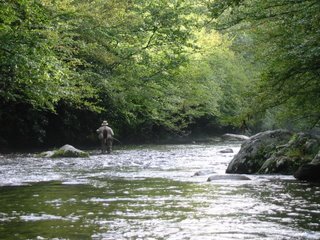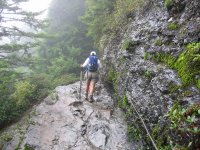 The picture is a little blury. It may be because the bear was running or maybe it is because the photographer was shaking. I kind of think that many wild bear pictures might be blury.
The picture is a little blury. It may be because the bear was running or maybe it is because the photographer was shaking. I kind of think that many wild bear pictures might be blury.This is a Black Bear in the Cades Cove section of the Great Smoky Mountains National Park (GSMNP). We went to the Smokys with Ted and Sherry Crawford of Johnstown PA. Sherry took this photo. I am sure that Sherry was steady, but the bear was moving. This is one of 6 bears that we saw last Tuesday. There are estimated to be about 1,700 bears in the park.
We first saw one bear in the woods beside the road. There was a "bear jam" which is a traffic jam in the GSMNP due to the spotting of a bear. There were 20 people out of their cars looking at the bear, some as close as 15 yards away. The bear was grazing on acorns in the woods. It obviously knew the people were there but it ignored them. A year or two ago a black bear killed a woman right near one of the streams that we normally fish not far from here. Usually the bears are not a threat to humans, but I wouldn't let my 5 year old kids get within 20 yards like some people did.
A little further down the road we saw the bear in the picture. It was the biggest of 4 bears travelling together. It appeared to be a mother with last years cubs. I believe that black bears only have cubs every other year. This bear actually charged a couple of people taking pictures who only had a barbed wire fence between them and the bear. Sherry got the picture as the bear retreated after the charge. Most charges are just a bluff to let someone know that they are getting too close.
This bear then joined the 3 smaller ones and together they moved to a very large oak tree in the middle of a field. Three deer ran from the field, stopping to look back at the bears every so often. All 4 bears climbed to the smallest outer branches of the tree and stripped acorns from the branches. We watched them for 20 minutes until the light started to fade. It was amazing how agile the bears were in the tree. They climbed straight up the broad trunk just like a cat might. They stood on one leg and reached out to the smallest branches for acorns. Three weeks ago we saw bears in the wild cherry trees in the park doing the same climbing for cherries.
A few minutes later we saw another very large bear grazing for acorns under another oak tree in a field.
 This last photo has nothing to do with the bears. It is just a picture of the sun shinning down through the trees as we were leaving the Cades Cove area on Wednesday. It was a great time to visit the Smokys. The weather was crisp and cool and the park wasn't jammed up with leaf lookers. October is the second most busy month in the park after July.
This last photo has nothing to do with the bears. It is just a picture of the sun shinning down through the trees as we were leaving the Cades Cove area on Wednesday. It was a great time to visit the Smokys. The weather was crisp and cool and the park wasn't jammed up with leaf lookers. October is the second most busy month in the park after July.Don't forget you can click on the pictures for a bigger view.













